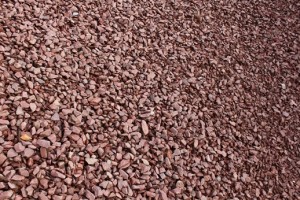“Why do we have these small, black spots all over our siding and windows?!”
Are you noticing small spots on your home, car, patio furniture or anything else in close proximity of your mulch beds? If so, you have some Artillery Fungus nearby.
Artillery fungus is a wood-decaying fungus that likes to live in landscape mulch. The fruiting bodies of this fungi are about 1/10 of an inch across and are very hard to see. They resemble the end of a cannon barrel and shoot their spores up 6-10 ft. onto objects nearby. There have even been instances on windy days where they’ve made their way onto surfaces as high as a second story.
In its natural habitat, artillery fungi shoot spores towards sunlight. At your home, the fungus may behave differently. Lack of direct sunlight will cause the fungi to shoot spores at reflective surfaces, like white siding or cars. Obviously the dark spores are easily spotted on lighter color surfaces as well.
Artillery fungus has been more prevalent than it has in the past. Landscaping over the past several decades has included the use of wood mulch. In the past, purely bark mulch would have been more typical. Cool spring and fall periods will always yield more of the fungus as well. It’s common to notice this fungi growing in shady environments and on the east and north sides of homes. Beds that aren’t in full sun most of the day are most susceptible. However, artillery fungus has been found in full-sun environments as well.
Spores are very sticky and don’t take long to fasten themselves to surfaces. This makes them almost impossible to remove with most cleaners. They don’t pose any damage risk to surfaces other than cosmetic.
“So how do I keep from having or getting more artillery fungus?”
Where there is decaying wood (all mulch) there is the possibility of fungi. There is no way for you, a mulch supplier, or a landscaper to know if their mulch has this fungi in it. Artillery fungus may already be present at the site. It could be transported by wind from your neighbor’s house. It may also be stuck to leaves that blow into your lawn. Another possibility is that it could come on nursery plants that you plant in your flower beds. Artillery fungus not something that can be easily avoided.
There is no conclusive research about mulches that won’t grow the fungi. However, it has been shown that artillery fungi doesn’t grow as prevalently in large pine bark nuggets because they don’t get as soft and wet as other mulches.

“So is there anything that can help me?”
If you spot a small group of the fungus, cover it with plastic. Then, dig it out and remove it from the site. Covering it before dislodging it may keep the projectiles from launching while moving it.
It has also been shown that adding mushroom compost to your mulch beds on a regular basis has been shown to reduce artillery fungus. Adding 40% by volume to a typical mulching will greatly suppress the spread of artillery fungus. Likewise, property owners that put down mulch annually generally have less artillery fungus problems than ones that do so every couple years.
In extreme cases, you can actually physically remove all of the mulch from your site and start over with new mulch. But, again, there isn’t any guarantee that the new mulch won’t contain the fungus. Some property owners have elected to replace mulch with decorative gravel, particularly in foundation beds that border light-colored siding or surfaces. Replacing either of those materials with groundcover plants could also be a desired alternative.
If you’d like more help with making your decision consult with a landscape company that is knowledgeable about artillery fungus, mulch and gravel options, and has a heart to help you find what solution is best for you. To read more from Penn State about artillery fungus and some suggestions about removing it from cars, buildings, etc. click here. If you’d like help addressing your landscaping concerns relating to artillery fungus, we’d love to talk with you about your project.

